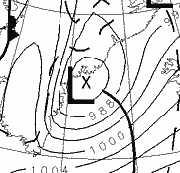Ideal conditions for surfing is a low pressure(s) out at sea to push the waves in, and an offshore or side-shore wind to hold them up and stop them from crashing too early. An onshore wind makes the waves very messy and creates a lot of whitewater. You will need to know which direction your local beaches face and which winds suit them best. It's always easiest to ask the locals.

|
Get to know as many local surfers as possible. This may seem obvious but its very important. Not only do you have people to go surfing with, but you can inform eachother of the best swells via SMS or whatever. Oh yeah, you make new friends also!
No matter how much you read up about this topic, it will take experience before you can judge swells properly (unless you're smarter then the rest of us!). You will often find yourself turning up at the beach, expecting waves, ready to go, and seeing just a flat ocean or expecting big waves and find onshore messy whitewater. There are many reasons, but best left for yourself to discover, so that you will learn better. The weather after the 9 O' clock news is another good resource for judging the weather.
When I was starting out, the only advice given to me was watch out for low pressures and that generally there are waves when its cloudy. After that I worked it out for myself, and had a lot of wasted trips to the beach.
 Figure 1
Figure 1
